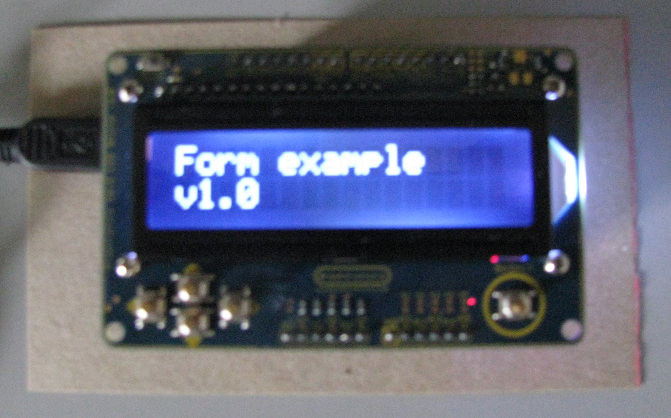The Form and Field classes simplify the process of building user interfaces for Arduino projects that use a Freetronics LCD shield. That shield has a 16x2 LCD display and five buttons for Up, Down, Left, Right, and Select.
The user interface is organised as a "form" which consists of one or more "fields" that display or modify a single program parameter. The Left and Right buttons are used to navigate between fields, and the Up and Down buttons are used to modify the value of the currently-displayed field.
We start by including the classes from the library that we will need:
#include <LCD.h>
#include <Form.h>
#include <TextField.h>
#include <TimeField.h>
#include <IntField.h>
#include <BoolField.h>
Next, we initialize the LCD display, create the main form, and populate it with fields:
TextField welcomeField(mainForm,
"Form example",
"v1.0");
TimeField timeField(mainForm,
"Time since reset", 24, TIMEFIELD_READ_ONLY);
IntField volumeField(mainForm,
"Volume", 0, 100, 5, 85,
"%");
BoolField ledField(mainForm,
"Status LED",
"On",
"Off",
true);
TimeField durationField(mainForm,
"Timer duration", 24, TIMEFIELD_READ_WRITE);
Each field has a specific type, which may be one of the following classes:
- BoolField displays a boolean on/off value with the Up and Down buttons used to toggle its state.
- IntField displays an integer value within a specified range, with the Up and Down buttons used to modify the value.
- TextField displays a read-only value, which is typically used for status messages and program results.
- TimeField displays a time in hours, minutes, and seconds. The field may be either read-only or writable. Writable time fields can be modified with the Up, Down, Left, and Right buttons to select a specific duration.
Returning to our example, the above code creates the following fields:
welcomeField to display the program's name and version. timeField to display the number of seconds since reset, wrapping around after 24 hours. This field is read-only. volumeField which displays a volume between 0 and 100, with an Up/Down step of 5, and a suffix of "%". ledField which displays the current boolean state of the status LED on D13; the LED will change state when the user toggles the field's value. durationField which displays a read-write time field for selecting a duration between 0 and 24 hours.
Now that we have defined our form, we need to initialize the program and show the form for the first time:
#define STATUS_LED 13
void setup() {
pinMode(STATUS_LED, OUTPUT);
digitalWrite(STATUS_LED, HIGH);
mainForm.show();
}
An application can have multiple forms, but only one can be shown at any given time. To switch to another form, call Form::hide() on the old form and Form::show() on the new form.
All that remains is to define our application's loop function which retrieves button events from LCD::getButton() and dispatches them to the form:
void loop() {
timeField.setValue(millis() / 1000);
if (mainForm.dispatch(event) == FORM_CHANGED) {
if (mainForm.isCurrent(ledField)) {
if (ledField.value())
digitalWrite(STATUS_LED, HIGH);
else
digitalWrite(STATUS_LED, LOW);
}
}
}
The full source code for the example follows:
#include <LCD.h>
#include <Form.h>
#include <TextField.h>
#include <TimeField.h>
#include <IntField.h>
#include <BoolField.h>
TextField welcomeField(mainForm,
"Form example",
"v1.0");
TimeField timeField(mainForm,
"Time since reset", 24, TIMEFIELD_READ_ONLY);
IntField volumeField(mainForm,
"Volume", 0, 100, 5, 85,
"%");
BoolField ledField(mainForm,
"Status LED",
"On",
"Off",
true);
TimeField durationField(mainForm,
"Timer duration", 24, TIMEFIELD_READ_WRITE);
#define STATUS_LED 13
void setup() {
pinMode(STATUS_LED, OUTPUT);
digitalWrite(STATUS_LED, HIGH);
mainForm.show();
}
void loop() {
timeField.setValue(millis() / 1000);
if (mainForm.dispatch(event) == FORM_CHANGED) {
if (mainForm.isCurrent(ledField)) {
if (ledField.value())
digitalWrite(STATUS_LED, HIGH);
else
digitalWrite(STATUS_LED, LOW);
}
}
}

 1.8.6
1.8.6